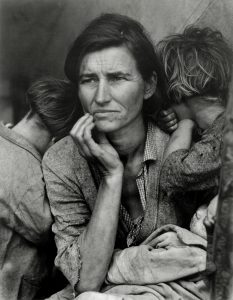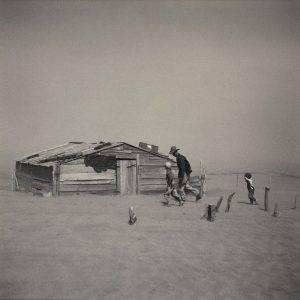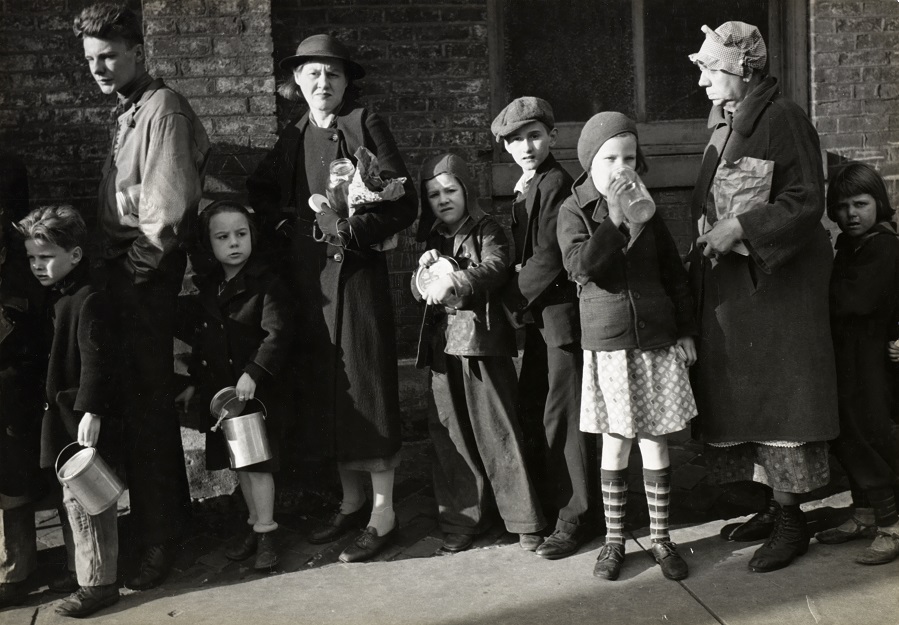Depression-Era Photography Exhibition Showcases Resiliency of Human Spirit
Kansas City, MO. June 7, 2017– A new exhibition featuring works by some of the most well-known American photographers of the 1930s will be on display at The Nelson-Atkins Museum of Art in Kansas City. Dignity vs. Despair: Dorothea Lange and Depression-Era Photographers, 1933-1941 opens June 23 and includes iconic images by five photographers: Dorothea Lange, Walker Evans, Arthur Rothstein, Marion Post Wolcott, and Peter Sekaer. It is the first Depression-era exhibition at the Nelson-Atkins.
The Farm Security Administration, created in response to the Great Depression, provided loans to farmers, facilitated the removal of families from economically challenged cities for resettlement in rural communities, and formed camps for migrant workers.

“The themes of adversity and resilience in these photographs are some of the same themes running through contemporary life,” said Julián Zugazagoitia, Menefee D. and Mary Louise Blackwell CEO & Director of the Nelson-Atkins. “With the downturn of the economy in 2008, many people found themselves facing increased hardship. These photographs help us better understand not only the strength of the human spirit in times of suffering, but also the remarkable power of social and documentary photography to shape public opinion and influence government decisions.”
In 1935, Roy Stryker, an economist from Colombia University, was given the difficult task of determining how to prepare pictorial documentation of rural areas and problems and present them to the American government and people. He assembled an initial team of five photographers, including Dorothea Lange, Walker Evans, and Arthur Rothstein. Marion Post Wolcott and Peter Sekaer worked for other government agencies.
“Many people dismiss these images as sad photographs, but I’ve never seen them that way,” said Jane L. Aspinwall, Associate Curator, Photography. “Roy Stryker didn’t see them that way either. He recognized in the photos a quiet human dignity, something that, as he described it, ‘transcends misery’ and reflects our ‘ability to endure.’”
The exhibition of 64 photographs is arranged thematically and geographically into three sections. The first section includes Lange’s images of urban hardship in San Francisco in 1933-38. The next section focuses on the South, an area hard hit by the Depression. The final section documents the plight of the migrant worker, most often located in California.

“It was an important watershed moment in the history of photography when the American government dispatched photographers to record the plight of the poor and the successes of federal programs,” said Aspinwall. “These photographs were meant to ‘show America to Americans’—to demonstrate that the government recognized their hardships and was working to relieve them.”
The exhibition draws heavily upon the photographers’ own words about their work, found in captions on the backs of the photos, artists’ field notes, and excerpts from interviews. These materials expand the exhibition beyond the subject matter and allow viewers a greater understanding of each photographer’s point of view.
To highlight the museum’s extensive holding of Dorothea Lange’s work, her photographs—including the highly recognizable Migrant Mother—make up more than half of the photos in the exhibition. Migrant Mother, one of the most requested photos by visitors, was featured on the PBS program Antiques Roadshow in 2013. Dignity vs. Despair will be on view until November 26.
Image captions: Peter Sekaer, American, born Denmark (1901–1950). Louisville, Kentucky, ca. 1936. Gelatin silver print, 6 1/2 × 9 3/8 inches. Gift of the Hall Family Foundation, 2016.75.260.
Dorothea Lange, American (1895–1965). Migrant Mother, Nipomo, California, March 1936. Gelatin silver print (printed ca. 1960), 13 3/8 x 10 1/4 inches. Gift of Hallmark Cards, Inc., 2005.27.305.
Arthur Rothstein, American (1915–1985). Farmer and sons in dust storm, Cimarron County, Oklahoma, April 1936. Gelatin silver print, 21 7/8 x 17 7/8 inches. Gift of Hallmark Cards, Inc., 2005.27.4330.
This exhibition is supported by the Hall Family Foundation.
The Nelson-Atkins Museum of Art
The Nelson-Atkins in Kansas City is recognized nationally and internationally as one of America’s finest art museums. The museum, which strives to be the place where the power of art engages the spirit of community, opens its doors free of charge to people of all backgrounds. The museum is an institution that both challenges and comforts, that both inspires and soothes, and it is a destination for inspiration, reflection and connecting with others.
The Nelson-Atkins serves the community by providing access to its renowned collection of nearly 40,000 art objects and is best known for its Asian art, European and American paintings, photography, modern sculpture, and new American Indian and Egyptian galleries. Housing a major art research library and the Ford Learning Center, the Museum is a key educational resource for the region. In 2017, the Nelson-Atkins celebrates the 10-year anniversary of the Bloch Building, a critically acclaimed addition to the original 1933 Nelson-Atkins Building.
The Nelson-Atkins is located at 45th and Oak Streets, Kansas City, MO. Hours are Wednesday, 10 a.m.–5 p.m.; Thursday/Friday, 10 a.m.–9 p.m.; Saturday, 10 a.m.–5 p.m.; Sunday, 10 a.m.–5 p.m. Admission to the museum is free to everyone. For museum information, phone 816.751.1ART (1278) or visit nelson-atkins.org.
For media interested in receiving further information, please contact:
Kathleen Leighton, Manager, Media Relations and Video Production
The Nelson-Atkins Museum of Art
816.751.1321
kleighton@nelson-atkins.org
